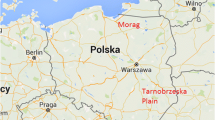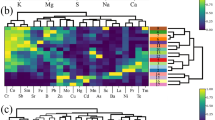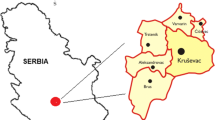Abstract
Macro-elements (Ca, Fe, K, Mg and Na) and trace elements including some toxic (As, Be, Cd, Co, Cu, Mn, Ni, Pb, Se and Zn) were determined in edible and inedible wild-growing mushrooms (Amanita rubescens, Auricularia polytricha, Boletus edulis, Boletus mirabilis, Clavulina cristata, Helvella crispa, Lactarius deliciosus, Suillus luteus, Termitomyces microcarpus, Termitomyces reticulatus, Termitomyces clypeatus, Termitomyces umkowaanii, Amanita foetidissima, Amanita muscaria, Amanita pantherina, Aseroe rubra, Chlorophyllum molybdites, Ganoderma lucidum, Gymnopilus junonius, Hypholoma fasciculare, Lentinus villosus, Lepista caffrorum, Pycnoporus sanguineus, Panaeolus papilionaceus, Pisolithus tinctorius, Pleurotus ostreatus, Podaxis pistillaris, Russula sardonia, Scleroderma citrinum, Scleroderma michiganense). Analyses of samples were carried out using inductively coupled plasma-optical emission spectrometry. The elemental content in both edible and inedible mushrooms, in decreasing order, was found to be K >> Na > Ca > Mg > Fe > Mn > Zn > Cu > Se > Co > Ni > Be > Pb ≥ Cd > As. Our study revealed that the accumulation of metals from the soil is independent of whether mushrooms are edible or inedible as uptake is dependent on the soil quality and its environment. Edible mushroom species studied were found to be rich in Se (145–836% towards the RDA) with B. edulis being rich in it, C. cristata in Cu, S. luteus in Fe and H. crispa in Zn, and all contained low concentrations of toxic metals making them suitable for human consumption.




Similar content being viewed by others
References
Alonso J, García MA, Pérez-López M, Melgar MJ (2003) The concentrations and bioconcentration factors of copper and zinc in edible mushrooms. Arch Environ Contam Toxicol 44(2):0180–0188
Blanuša M, Kučak A, Varnai VM, Sarić MM (2001) Uptake of cadmium, copper, iron, manganese, and zinc in mushrooms (Boletaceae) from Croatian forest soil. J AOAC Int 84(6):1964–1971
Claxton LD (2015) The history, genotoxicity and carcinogenicity of carbon-based fuels and their emissions: part 4–alternative fuels. Mutation Research/Reviews in Mutation Research 763:86–102
Cocchi L, Vescovi L, Petrini LE, Petrini O (2006) Heavy metals in edible mushrooms in Italy. Food Chem 98:277–284
Cocchi L, Kluza K, Zalewska T, Apanel A, Falandysz J (2017) Radioactive caesium (134Cs and 137Cs) in mushrooms of the genus Boletus from the Reggio Emilia in Italy and Pomerania in Poland. Isot Environ Health Stud 53(6):620–627
Commission N P (2012) National Development Plan 2030: our future–make it work. Presidency of South Africa, Pretoria
Costa-Silva F, Marques G, Matos CC, Barros AI, Nunes FM (2011) Selenium contents of Portuguese commercial and wild edible mushrooms. Food Chem 126(1):91–96
Drewnowska M, Falandysz J (2015) Investigation on mineral composition and accumulation by popular edible mushroom common chanterelle (Cantharellus cibarius). Ecotoxicol Environ Saf 113:9–17
Drewnowska M, Hanć A, Barałkiewicz D, Falandysz J (2017) Pickling of chanterelle Cantharellus cibarius mushrooms highly reduce cadmium contamination. Environ Sci Pollut Res 24(27):21733–21738
Eicker A (1990) Commercial mushroom production in South Africa. Cape and Transvaal Printers (Pty) Ltd, Cape Town
EU. Commission Regulation (EC) No 629/2008 of 2 July 2008 amending regulation (EC) No 1881/2006 setting maximum levels for certain contaminants in food- stuffs, Official Journal of the European Union. (372008 L173/6–9)
Falandysz J (2008) Selenium in edible mushrooms. Journal of Environmental Science and Health Part C 26(3):256–299
Falandysz J (2013) On published data and methods for selenium in mushrooms. Food Chem 138(1):242–250
Falandysz J, Bielawski L (2007) Mercury and its bioconcentration factors in brown birch scaber stalk (Leccinum scabrum) from various sites in Poland. Food Chem 105:635–640
Falandysz J, Borovička J (2013) Macro and trace mineral constituents and radionuclides in mushrooms: health benefits and risks. Appl Microbiol Biotechnol 97(2):477–501
Falandysz J, Drewnowska M (2015) Distribution of mercury in Amanita fulva (Schaeff.) Secr. mushrooms: accumulation, loss in cooking and dietary intake. Ecotoxicol Environ Saf 115:49–54
Falandysz J, Rizal LM (2016) Arsenic and its compounds in mushrooms: a review. Journal of Environmental Science and Health, Part C 34(4):217–232
Falandysz J, Chudzińska M, Barałkiewicz D, Drewnowska M, Hanć A (2017a) Toxic elements and bio-metals in Cantharellus mushrooms from Poland and China. Environ Sci Pollut Res 24(12):11472–11482
Falandysz J, Zhang J, Wiejak A, Barałkiewicz D, Hanć A (2017b) Metallic elements and metalloids in Boletus luridus, B. magnificus and B. tomentipes mushrooms from polymetallic soils from SW China. Ecotoxicol Environ Saf 142:497–502
Falandysz J, Mędyk M, Treu R (2018) Bio-concentration potential and associations of heavy metals in Amanita muscaria (L.) Lam. from northern regions of Poland. Environ Sci Pollut Res 25(25):25190–25206
Ferreira ICFR, Vaz JA, Vasconcelos MH, Martins A (2010) Compounds from wild mushrooms with antitumor potential. Anticancer Agents in Medicinal Chemistry 10(5):424–436
Gałgowska M, Pietrzak-Fiećko R (2017) Pesticide contaminants in selected species of edible wild mushrooms from the north-eastern part of Poland. J Environ Sci Health B 52(3):214–217
García MÁ, Alonso J, Melgar MJ (2009) Lead in edible mushrooms levels and bioaccumulation factors. J Hazard Mater 167:777–783
García MÁ, Alonso J, Melgar MJ (2015) Radiocaesium activity concentrations in macrofungi from Galicia (NW Spain): influence of environmental and genetic factors. Ecotoxicol Environ Saf 115:152–158
Gençcelep H, Uzun Y, Tunçtürk Y, Demirel K (2009) Determination of mineral contents of wild-grown edible mushrooms. Food Chem 113:1033–1036
Gucia M, Jarzyńska G, Rafał E, Roszak M, Kojta AK, Osiej I, Falandysz J (2012) Multivariate analysis of mineral constituents of edible parasol mushroom (Macrolepiota procera) and soils beneath fruiting bodies collected from Northern Poland. Environ Sci Pollut Res 19(2):416–431
Hall IR, Stephens SL, Buchanan PK, Yun W, Cole ALJ (2003) Edible and poisonous mushrooms of the world. Colorcraft Ltd, Hong Kong
Hatfield D L, Berry MJ, Gladyshev VN (2011) Selenium: its molecular biology and role in human health. Springer Science & Business Media
Herrmann A, Hedman H, Rosén J, Jansson D, Haraldsson B, Hellenäs K (2012) Analysis of the mushroom nephrotoxin orellanine and its glucosides. J Nat Prod 75(10):1690–1696
Jennings DH, Lysek G (1996) Fungal biology: understanding the fungal lifestyle. BIOS Scientific Publishers Limited
Jonnalagadda SB, Pienaar DH, Haripersad K (2006) Elemental distribution in selected Agaricus and Rhizina mushrooms in South Africa. J Environ Sci Health A 41:507–514
Kabata-Pendias A (2010) Trace elements in soils and plants. Taylor and Francis Group, LLC, USA
Kalač P (2009) Chemical composition and nutritional value of European species of wild growing mushrooms: a review. Food Chem 113(1):9–16
Kalač P, Svoboda L (2000) A review of trace element concentrations in edible mushrooms. Food Chem 69:273–281
Kemp K (2002) Heavy metals in edible mushrooms. Int J PIXE 12(3 & 4):117–124
Kojta AK, Falandysz J (2016) Metallic elements (Ca, Hg, Fe, K, Mg, Mn, Na, Zn) in the fruiting bodies of Boletus badius. Food Chem 200:206–214
Korb B (2011) Holding our breath: waiting for the federal government to recognize coal ash as a hazardous waste. John Marshall Law Review 45:1177
Lepp NW, Harrison SCS, Morrell BG (1987) A role for Amanita muscaria L. in the circulation of cadmium and vanadium in a non-polluted woodland. Environ Geochem Health 9(3–4):61–64
Levin H, Branch M (1985) A field guide to the mushrooms of South Africa. C. Struik
Liu YT, Sun J, Luo ZY, Rao SQ, Su YJ, Xu RR, Yang YJ (2012) Chemical composition of five wild edible mushrooms collected from Southwest China and their antihyperglycemic and antioxidant activity. Food Chem Toxicol 50(5):1238–1244
Malinowska E, Szefer P, Falandysz J (2004) Metals bioaccumulation by bay bolete, Xerocomus badius, from selected sites in Poland. Food Chem 84:405–416
Mdachi SJM, Nkunya MHH, Ngiyo VA, Urasa IT (2004) Amino acid composition of some Tanzanian wild mushrooms. Food Chem 86(2):179–182
Mędyk M, Grembecka M, Brzezicha-Cirocka J, Falandysz J (2017) Bio-and toxic elements in mushrooms from the city of Umeå and outskirts. Sweden Journal of Environmental Science and Health, Part B 52(8):577–583
Mehdi Y, Hornick J, Istasse L, Dufrasne I (2013) Selenium in the environment, metabolism and involvement in body functions. Molecules 18(3):3292–3311
Melgar M, Alonso J, García MA (2014) Total contents of arsenic and associated health risks in edible mushrooms, mushroom supplements and growth substrates from Galicia (NW Spain). Food Chem Toxicol 73:44–50
Melgar M, Alonso J, García MA (2016) Cadmium in edible mushrooms from NW Spain: bioconcentration factors and consumer health implications. Food Chem Toxicol 88:13–20
Miles PG, Chang S, (1997) Mushroom biology: concise basics and current development. World Scientific Publishing Co. Pty, Ltd
Miles PG, Chang S (2004) Mushrooms: cultivation, nutritional value, medicinal effect, and environmental impact. CRC Press, Boca Raton, Florida
Morais S, e Costa FG, de Lourdes Pereira, M (2012) Heavy metals and human health. Environmental Health-Emerging Issues and Practice, In Tech
Navarro MJ, Merino L, Gea FJ (2017) Evaluation of residue risk and toxicity of different treatments with diazinon insecticide applied to mushroom crops. J Environ Sci Health B 52(3):218–221
Persson H (2012) Mushrooms. Medicine 40(3):135–138
Petkovšek SA, Pokorny B (2013) Lead and cadmium in mushrooms from the vicinity of two large emission sources in Slovenia. Sci Total Environ 443:944–954
Sangvichien E, Taylor-Hawksworth P (2001) Termitomyces mushrooms: a tropical delicacy. Mycologist 15(1):31–33
Širić I, Humar M, Kasap A, Kos I, Mioč B, Pohleven F (2016a) Heavy metal bioaccumulation by wild edible saprophytic and ectomycorrhizal mushrooms. Environ Sci Pollut Res 23(18):18239–18252
Širić I, Kasap A, Kos I, Markota T, Tomić D, Poljak M (2016b) Heavy metal contents and bioaccumulation potential of some wild edible mushrooms. Šumarski List 140(1–2):29–37
Sithole SC, Mugivhisa LL, Amoo SO, Olowoy JO (2017) Pattern and concentrations of trace metals in mushrooms harvested from trace metal-polluted soils in Pretoria. South Africa South African Journal of Botany 108:315–320
Stamets P (1993) Growing gourmet and medicinal mushrooms. Ten Speed Press, Berkeley
Stamets P (2000) Growing gourmet and medicinal mushrooms. Ten Speed Press, Berkeley, CA
Szántó Zs HM, Wätjen U, Altzitzoglou T (2007) Current radioactivity content of wild edible mushrooms: a candidate for an environmental reference material. J Radioanal Nucl Chem 273(1):167–170
Tazikeh H, Khormali F, Amini A, Motlagh MB (2018) Geochemistry of soils derived from selected sedimentary parent rocks in Kopet Dagh, north east Iran. J Geochem Explor 194:52–70
Trading economics (2018) South Africa Unemployment Rate 2000–2018. https://tradingeconomics.com/south-africa/unemployment-rate Accessed 29 Oct 2018
Tuzen M, Sesli E, Soylak M (2007) Trace element levels of mushroom species from East Black Sea region of Turkey. Food Control 18(7):806–810
Van Der Westhizen GCA, Eicker A (1994) Field guide: mushrooms of South Africa. Kyodo Printing Co. Ptv. Ltd, Singapore
Van der Westhuizen GCA, Eicker A (1990) Species of Termitomyces occurring in South Africa. Mycol Res 94(7):923–937
Vetter J (2004) Arsenic content of some edible mushroom species. Eur Food Res Technol 219(1):71–74
Waste, I. D. C. C (2010) In harm’s way: lack of federal coal ash regulations endangers Americans and their environment
World Food Summit, 13–17 November (1996) Rome, Italy. http://www.fao.org. Accessed 21 Feb 2013
Yamaç M, Yıldız D, Sarıkürkcü C, Çelikkollu M, Solak MH (2007) Heavy metals in some edible mushrooms from the Central Anatolia, Turkey. Food Chem 103:263–267
Zaidman BZ, Yassin M, Mahajna J, Wasser SP (2005) Medicinal mushroom modulators of molecular targets as cancer therapeutics. Appl Microbiol Biotechnol 67(4):453–468
Zalewska T, Cocchi L, Falandysz J (2016) Radiocaesium in Cortinarius spp. mushrooms in the regions of the Reggio Emilia in Italy and Pomerania in Poland. Environ Sci Pollut Res 23(22):23169–23174
Acknowledgements
The authors express their sincere appreciation to the Sappi, Mondi and Merensky companies for allowing us to collect samples from their pine plantations, the School of Chemistry and Physics at the University of KwaZulu-Natal for providing laboratory space, the Research Office of UKZN and the National Research Foundation ( SGD170612239662) for financial support. We are also indebted to Dr NT Mahlangeni for her immense support and willingness to assist with SPSS programme for statistical analysis.
Author information
Authors and Affiliations
Corresponding author
Ethics declarations
Conflict of interest
The authors declare that they have no conflict of interest.
Additional information
Responsible editor: Philippe Garrigues
Publisher’s note
Springer Nature remains neutral with regard to jurisdictional claims in published maps and institutional affiliations.
Electronic supplementary material
ESM 1
(DOCX 27 kb)
Rights and permissions
About this article
Cite this article
Rasalanavho, M., Moodley, R. & Jonnalagadda, S.B. Elemental distribution including toxic elements in edible and inedible wild growing mushrooms from South Africa. Environ Sci Pollut Res 26, 7913–7925 (2019). https://doi.org/10.1007/s11356-019-04223-0
Received:
Accepted:
Published:
Issue Date:
DOI: https://doi.org/10.1007/s11356-019-04223-0




